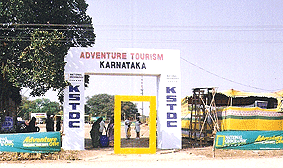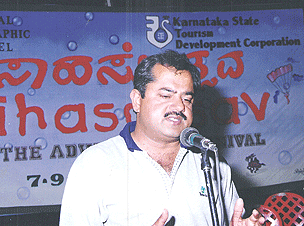

Sanjoy joined the IAS in 1979. His first
posting during training was at Chikmagalur
And then at Bijapur, Karwar after which he was posted to Vidhan Soudha
where he was attached to Chief Minister Ramakrishna Hegde. He next moved
to DoE at New Delhi where he was the National Project Coordinator, Computerised
Rural Information Systems(CRISP).
From there Sanjoy went on a deputation to IRMA followed by a sabbatical to APDC at Kuala Lumpur and AIT, Bangkok. On his return to the state, he was posted to Kolar and then to Raichur. He moved to KAIC and from there to IT and finally to KSTDC.
After his stint at KSTDC, he went on extraordinary leave to join Action Aid as the International Coordinator, IT for Development where he introduced ideas such as an online market for artisans and IT in Gambia.
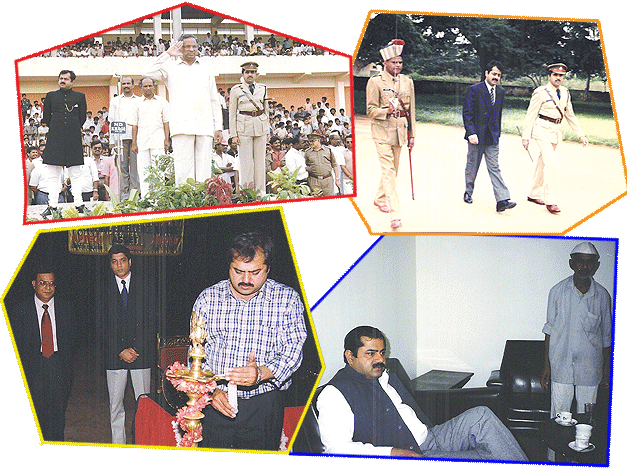
In between all this, he was also closely associated with Pradan and the Dhan Foundation.
His work through the last decade took him deeper and deeper into IT for Development and he worked to set up the Development Informatics Centre at CDSA.
For development action
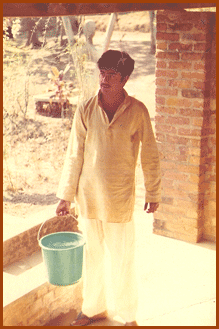
Sanjoy believed in action, not words. He seldom went to seminars and forums of discussion. He was known to put his money where his mouth was……..
His early understanding came from Jawaja where he lived and worked closely with the leather artisans to improve the design and marketing of the leather bags produced by the local artisans. This was based in Beawar, a small village in Rajasthan where he along with four other young men worked 'to enhance livelihood levels of the workers through a self-development programme'.
It was also from this place (living in a small hut, without electricity) that Sanjoy prepared for the IAS - experiencing poverty, deprivation and casteism. All this contributed to a part of his understanding of the need for 'rural development', and while his guru, Prof. Ravi Mathai and others developed the idea of 'The Rural University', he went on to join the IAS. Through the service and outside of it, Sanjoy associated with Actionaid, Pradan and Dhan Foundation to make development an experiential learning.
Prior to joining the IAS, Sanjoy had also
spent several months at Mitraniketan in Kerala, teaching English in the
local school. He had already done this once before at Sikkim where he
stayed for many months - again teaching English in return for boarding
and lodging. Each time, the experience reinforced the unifying diversity
and the need for national identity and pride.
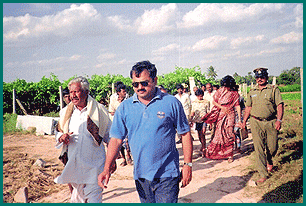
Foreword Muthur
The idea of creating a 'Model village' at Muthur was in the incubator for a long time before it came onto the drawing board. With a carefully put together core team of Dr. Reddy, Pani, George, Nandini, he drew in several others who could contribute in whichever way they could. Sanjoy visualized a complete modern intelligent village equipped to meet every internal community need as well as feed into the external environment. The village head Shammanna and Chandra Gowda met him many times and together with them, Sanjoy wove a dream, a vision and what was to be a reality in and for the future of Muthur.
The first effort was to start a village newspaper called "Muthur Times,' put together overnight by Shangon and her team. Then it was the start of the Muthur health camp by Nandini. The next move was to install a computer donated by Aliya which she had won at the horse show. The drawing board also had plans for computer literacy, e-mandi, community radio, health insurance, vocational classes in fact anything and everything that a modern living environment requires.
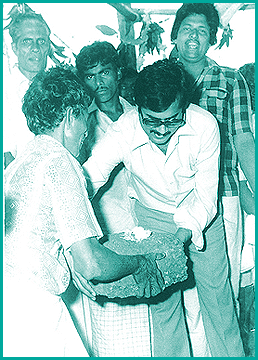
The first effort was to start a village newspaper called "Muthur Times,' put together overnight by Shangon and her team. Then it was the start of the Muthur health camp by Nandini. The next move was to install a computer donated by Aliya which she had won at the Great Banglaore Horse Show. The drawing board also had plans for computer classes, e-mandi, community radio, health insurance, jathropa fuel, vocational classes in fact, anything and everything that a model living environment requires.
Muthur was a logical synergy of many ideas, experiences and experiments. And despite the range of initiatives, all the work had a common underlying theme of IT for development.
Out of the box......
In the course of his work, Sanjoy left a trail of goodwill, nuturing relationships which went way beyond the immediate work.
In each of his postings, Sanjoy used the opportunity to innovate within the system. Each of his postings had highlights which reflected his out-of the box way of working.
![]() At Bijapur, he organised the History seminar where eminent historians
and academicians from across the country came to dialogue on the 'living'
history of the city. He also worked with the municipality introducing
ideas like the 'shramdhaan' to clean up the town.
At Bijapur, he organised the History seminar where eminent historians
and academicians from across the country came to dialogue on the 'living'
history of the city. He also worked with the municipality introducing
ideas like the 'shramdhaan' to clean up the town.
![]() When he acquired the
first computer at Karwar from Eiko, he used the XT to computerise land
records and build a village database.
When he acquired the
first computer at Karwar from Eiko, he used the XT to computerise land
records and build a village database.
![]() He tied up his field
experiences in an academic frame when he spent a year at IRMA while designing
a foundation course for human resource development in IT for rural India
for the PG students. He also went on to advice the management on introducing
IT to all management courses being taught.
He tied up his field
experiences in an academic frame when he spent a year at IRMA while designing
a foundation course for human resource development in IT for rural India
for the PG students. He also went on to advice the management on introducing
IT to all management courses being taught.
![]() While at Kolar he put together the Agriexpo '98 at Muthur where
over 5000 farmers came everyday to participate in the showcasing of agriculture.
While at Kolar he put together the Agriexpo '98 at Muthur where
over 5000 farmers came everyday to participate in the showcasing of agriculture.
![]() At KAIC, Sanjoy introduced the idea of the 'flower auction' and
the 'factory-on-wheels'.
At KAIC, Sanjoy introduced the idea of the 'flower auction' and
the 'factory-on-wheels'.
![]() As Secretary IT, he
organised the IT.com as well as directed policy planning and development
of IT in the state.
As Secretary IT, he
organised the IT.com as well as directed policy planning and development
of IT in the state.
![]() At KSTDC, he promoted
the idea of 'rural tourism', golf tourism packages, introduction of Air
Taxi systems and the concept of home stays' before organising the Adventure
Carnival.
At KSTDC, he promoted
the idea of 'rural tourism', golf tourism packages, introduction of Air
Taxi systems and the concept of home stays' before organising the Adventure
Carnival.

![]()
Sanjoy was a great organizer. "What. Another event," was a frequent
comment of his wife, when she saw that look in his eyes.
The first major event that Sanjoy organized was a seminar on the history of Bijapur in 1983 on the scale that Bijapur had not seen before. The fact that Shangon was expecting their first child and could hardly cope with the event, heat and a houseful of guests did not matter. "It's good for Bijapur," he explained, and indeed believed, earnestly.
|
Sanjoy put together a cricket team in Bijapur and organized matches every Sunday. He later went on to organize the Moffussil cricket tournament from Kolar and Raichur where he placed a 350cc bullet motorcycle for the best cricketer. The gorgeous red byke was the envy of everyone in the state. He also organized the 'huzoor jamabandi' where the entire office went to the tehsil and camped there for revenue collection. Later in Raichur he organized the Capt Munn's tennis tournament where he invited the British High Commission to send in their senior representative to grace and felicitate the event. The 'oh so propah' first Secretary was taken aback with the effort to made by the local District Commissioner to honour an old war soldier who way back played lawn tennis in Lingsagur! The National Games in 1996 was a landmark event. 15 days before the start of the Games, the GoK appointed Sanjoy as Officer on Special Duty' for the National Games. He took over an ill-equipped secretariat and reconstructed the games village to create a thrilling experience of the times. From Mosquito coils to water supply, ceremonial flags to inviting Chief Guests, caterers to waste disposal were areas that were ironed out by the OSD to ensure smooth conduct of the games. The National Games went on - eventlessly. |
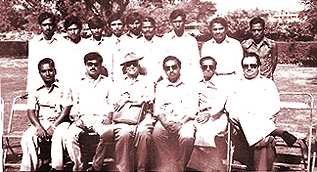 |
|
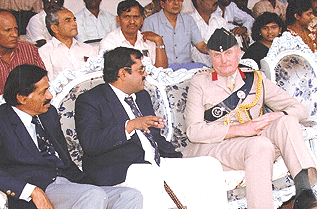 |
Other major events were Agro fair at Muthur, Sahasutsav (Adventure Sports), factory on wheels, the Harry Potter Carnival and of course the IT.Com for the first two years.
IT.Com was a unique event organized to strategically position Bangalore as the IT Capital of India. The specially created logo for the event cleverly articulated this. The design itself made the event pay for itself with almost no contribution in cash from the organizers - yet the mileage from this was unprecedented. Inaugurated by the Prime Minister of India, the IT.Com showcased not just the existing support and future plans - but also outlined how it was inevitable. The second time round it was on a larger scale and had the President of India introduce it again, the scale was grander, wider and deeper. Special theme pavilions were constructed and a range of related events across the city were organized to make IT an inclusive event.
Sanjoy was thrilled when IT.Com was held for the 3rd year by the next incumbent. But they forgot to invite him, ……
And finally the in 2004 and 2005. Great Bangalore Horse Show
And then there was none………
